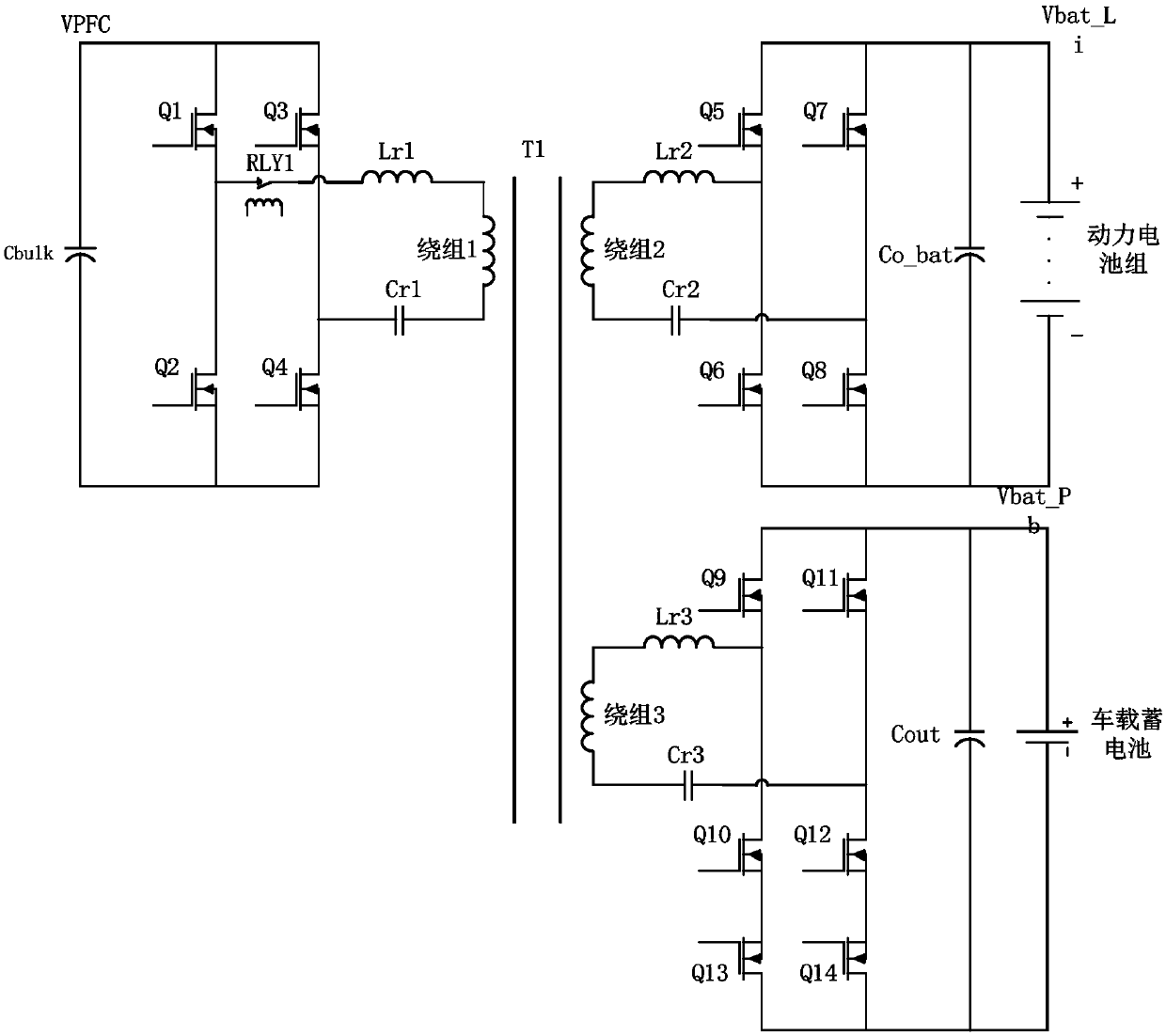Four-directional conversion vehicle charger and control method thereof
A vehicle-mounted charger and control method technology, applied in current collectors, electric vehicles, electrical components, etc., can solve problems such as single function, large volume, and high cost
- Summary
- Abstract
- Description
- Claims
- Application Information
AI Technical Summary
Problems solved by technology
Method used
Image
Examples
Embodiment 1
[0087] Technical solution 1 adopts three-way CLLC control technology, and adds a secondary winding to the main transformer as the side winding of the on-board battery to supply power to the battery and load, so as to realize the electrical integration of OBC and DC-DC. The schematic diagram of the specific circuit topology is as follows: image 3 shown.
[0088] image 3 Description of each device: T1 is the main transformer of the vehicle OBC+DC-DC integration, including three windings, the primary winding 1 is the mains input side, the secondary winding 2 is the power battery side, and the secondary winding 3 is the vehicle battery side; RLY1 is an electromagnetic relay; Lr1 is the mains side resonant inductance, Cr1 is the mains side resonant capacitor; Lr2 is the output power battery side resonant inductance, Cr2 is the output power battery side resonant capacitor; Lr3 is the output battery side resonant inductance, Cr3 is the battery side resonance capacitor; Cbulk is t...
Embodiment 2
[0101] Technical solution 2 adopts three-way CLLC control technology, adding a secondary winding to the main transformer as the vehicle battery side winding, and adding a buck circuit to output a stable voltage Vbat_Pb to supply power to the battery and load, so as to realize OBC and DC-DC electrical integration , the topology schematic diagram is as follows Figure 10 .
[0102] Figure 10 Description of each device: compared to image 3 The mains side is the same as the power battery side; the battery side reduces the common source MOS transistors Q13 and Q14 with Q10 and Q12, increases the switch MOS transistor Q15, electrolytic capacitor Co at Vpb, diode D1, electromagnetic relay RLY2, and BUCK inductance Lpb.
[0103] Specific control method:
[0104] Working status 1: car charging status:
[0105] The mains side and the power battery side are the same as the working state 1 of scheme 1; RLY2 on the battery side is disconnected, Q9, Q10, Q11, and Q12 realize synchrono...
Embodiment 3
[0113] Technical solution 3 also adopts the three-way CLLC control technology. The difference from the previous two solutions is that a buck / boost circuit is added on the battery side, which can not only make the battery side as the output side output a stable voltage Vbat_Pb, but also make the battery side as the input side. Boost Vbat_Pb to Vpb to better realize the function of charging the power battery pack. Topology diagram such as Figure 15 .
[0114] Solution 3 device description: On the basis of solution 2, D1 and RLY2 are removed, and an NMOS transistor Q16 is added.
[0115] Specific control methods:
[0116] Working state 1: car charging state
[0117] The mains side and the power battery side are the same as the working state 1 of scheme 1; the battery side Q16 is driven off, and the built-in body diode of Q16 is used as the diode in the BUCK circuit, and Q9, Q10, Q11, and Q12 pass the same Switching on and off realizes synchronous rectification, the secondary...
PUM
 Login to View More
Login to View More Abstract
Description
Claims
Application Information
 Login to View More
Login to View More - R&D
- Intellectual Property
- Life Sciences
- Materials
- Tech Scout
- Unparalleled Data Quality
- Higher Quality Content
- 60% Fewer Hallucinations
Browse by: Latest US Patents, China's latest patents, Technical Efficacy Thesaurus, Application Domain, Technology Topic, Popular Technical Reports.
© 2025 PatSnap. All rights reserved.Legal|Privacy policy|Modern Slavery Act Transparency Statement|Sitemap|About US| Contact US: help@patsnap.com



